Home › Forums › The Industrial Era › EUREKA! – The African Burial Ground in Van Cortlandt Park
- This topic has 1 reply, 2 voices, and was last updated 4 years, 10 months ago by
spabob.
-
AuthorPosts
-
-
June 16, 2019 at 2:54 am #1072
Here is the gist: I found an article that provides solid documentary evidence of the existence of the African Burial Ground in Van Cortlandt Park. This comes courtesy of the September 25, 1879 Porchester Journal and it appears under the title “Railroad Matters,”
While the level of detail leaves something to be desired, the fact relayed by Caleb Van Tassel is particularly noteworthy. According to this 1868 map, Van Tassel lived on today’s Horace Mann campus near W. 242nd Street and Broadway not far from the Van Cortlandt House on the right of the map.
The article refers to “Mosholu or South Yonkers” because the area had been part of Yonkers and the Mosholu post office was located at Warner’s Store, which you can see on the bottom left of the map. Broadway runs through the center of the map (north to south) and the Van Cortlandt Mansion is on the right. The testimony of Van Tassel, an eye-witness to the last days of slavery in the area, confirms the existence of the burial ground and suggests that he would have had knowledge of its location (more on that later). The New York and Northern Railroad was a successor to the New York and Boston Railroad that built the Putnam line. Somewhere (I will have to check my files to find where) I read that Caleb Van Tassel worked as a miller at the Van Cortlandt mills in the 1800s. So that’s the gist. If you want to know more, read on (fair warning: it is a commitment and probably more than you ever wanted to know!).
Another map (1872) shows Caleb Van Tassel owning property in today’s park by the lake. Note the C.V.T. on the right bank of the lake.
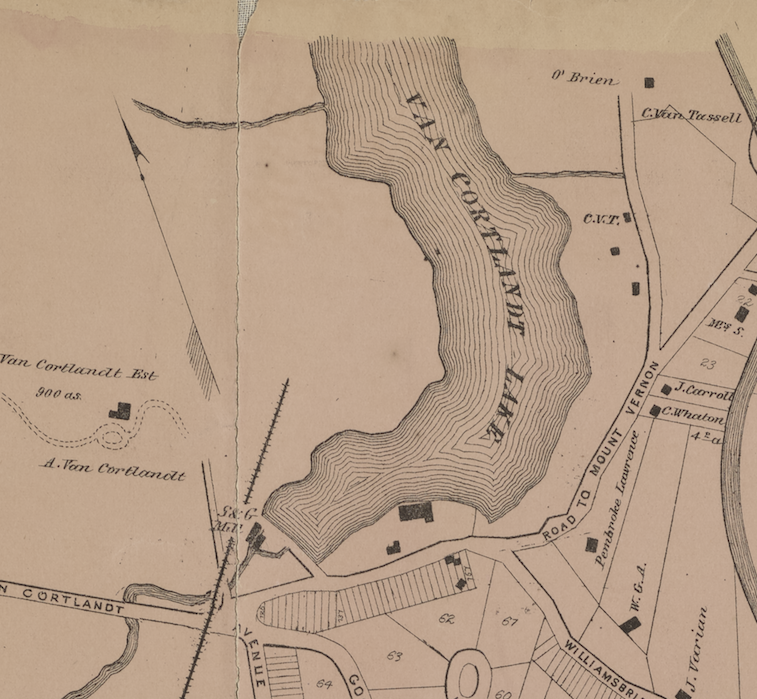
The above article from the Port Chester Journal appeared, word-for-word, in several local papers including the New York Tribune at about this time. My next steps will be to check the local Yonkers papers (the Yonkers Statesman and the Yonkers Gazette) in the hope that they have a more thorough write-up of the event. However, the fact that this was classified as a “railroad matter” does not give me optimism that journalists thought that digging up the bones was terribly extraordinary. There is also the problem that at this point, in 1879, Kingsbridge was no longer part of Yonkers so Yonkers papers would be carrying less Kingsbridge news. Additionally, I am going to try to find a deed for the 7 acres referred to in the article and see what that tells us.
Even though this is a small blurb, it was quite a saga to find this and there were many people involved in its rediscovery. Years ago I was telling Patrick Raftery at the Westchester County Historical Society what I knew about the Berrian/Tippett (or Kingsbridge) Burial Ground in Van Cortlandt Park. He did tremendous research on it for his books, The Cemeteries of Westchester County. In his research he found this gem from the Mount Vernon Daily Argus, which set events in motion (and inspired me to write about it):
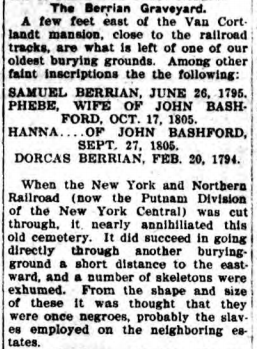
I had read vague references to an African burial ground in local histories but it did not fully register until Patrick found the above article (I still don’t know how he did it). But since the above blurb was a rehashing of something that occurred earlier, I felt compelled to find an original story from the time when the skeletons were actually dug up. I thought it should be easy enough to find something with the clues in the article but Googling turned up nothing. So, I used maps and written histories to get a rough idea of when the railroad was built. That led me to read five years (1868-1872) of The Yonkers Statesman newspaper on microfilm at the Yonkers Riverfront Library. Let’s just say that took a loooooooong time. But I don’t regret the time spent even though nothing about the African Burial Ground turned up in the Yonkers Statesman. I found a lot of other interesting stuff about the neighborhood and the country including the great migration in Yonkers:
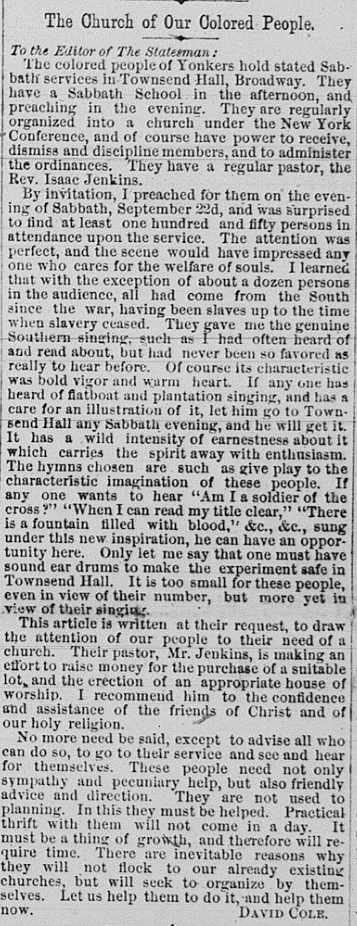
I found so many interesting articles on various topics (that I will someday write about) before coming across this in November of 1871:

It speaks to the state of the Van Cortlandt plantation post-slavery but also lead me to think that I was really close to finding something about the burial ground. But then I read through the papers from the beginning of 1872 and learned that there was a long winter followed by financial problems for the railroad. It seemed like the railroad would never be built and I would never find anything about the burial ground! And then I came across this in May of 1872:
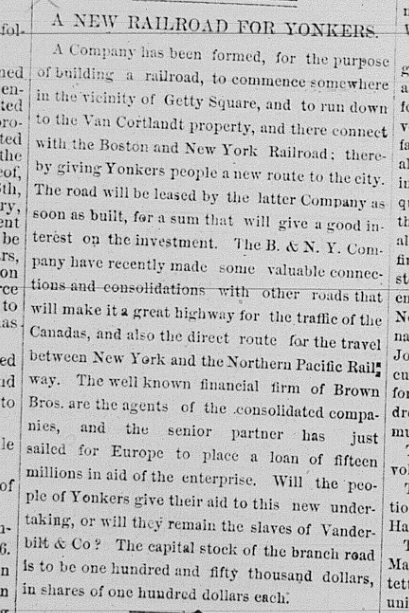
This “new railroad” that the article refers to is what would eventually be a spur off the main Putnam Line that went from Van Cortlandt Park Station to downtown Yonkers. The people of Yonkers were really dissatisfied with the New York Central Railroad and were desperate for a competitor to come along. This spur was the competitor and it went right across the Parade Ground of Van Cortlandt Park.
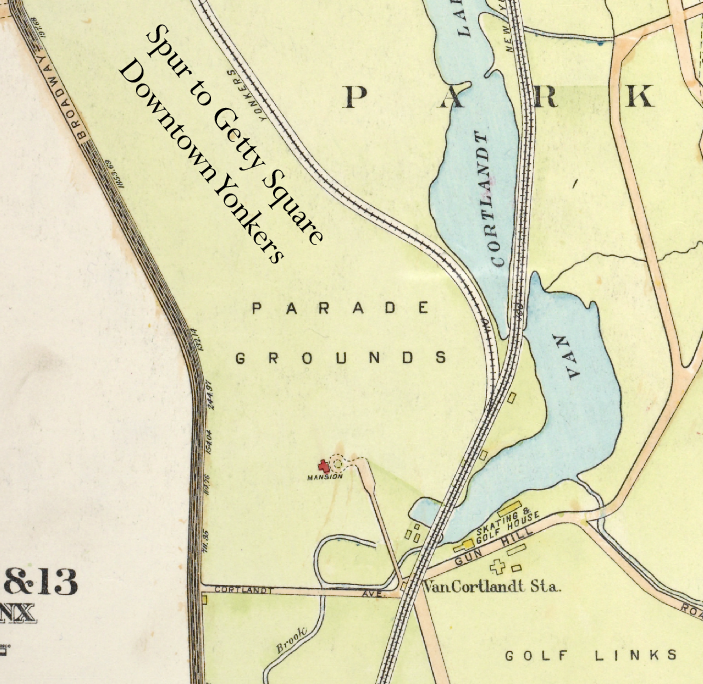
This got me thinking, what if the skeletons were not dug up during construction of the Putnam Line but rather during the construction of this spur to downtown Yonkers? John Favareau at the Yonkers Riverfront Library (which truly has an amazing staff) helped me pin down when the spur was built. That was extremely complicated because there were delays and lawsuits. John found some great leads on fultonhistory.com such as this one from the Yonkers Statesman: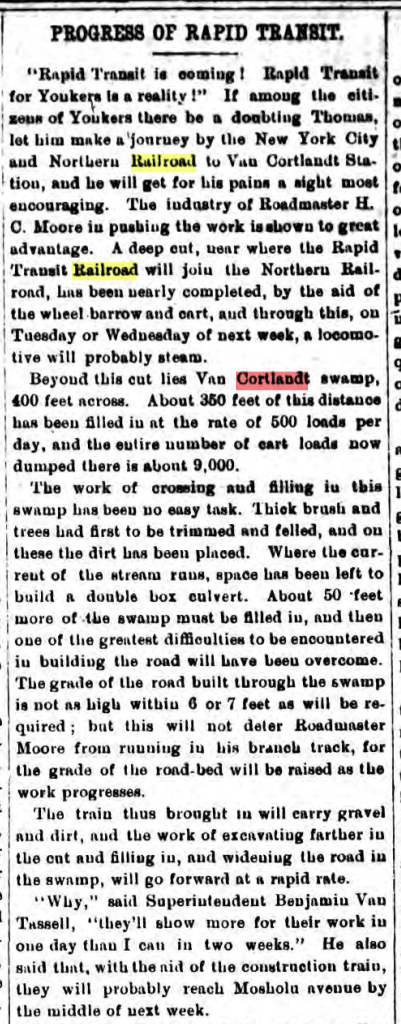
So, the construction of this spur required serious digging and the supervisor of the railroad construction was Benjamin Van Tassel, son of Caleb, who built the coffins for the enslaved! This only gives further credence to the 1879 article.
After playing around with different search terms on the fultonhistory.com, I found the article in the Portchester Journal.
Hopefully, this newly found article will satisfy the documentation requirement of the NYC Parks Dept. so that a sign can be made for the African Burial Ground in Van Cortlandt Park. But I am not done digging for information. Hopefully, more will turn up.
-
June 16, 2019 at 12:32 pm #1076
Very interesting article. I have to commend you on such diligent research. I grew up on Bailey Ave. during the ’50s. We used to spend quite a bit of time in “Vannie”. Love the history.
-
-
AuthorPosts
- You must be logged in to reply to this topic.